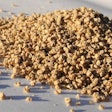Rapid and efficient broiler growth is usually synonymous with profitability. Nevertheless, there are specific circumstances for which a slower growth rate is desirable. Such cases usually refer to the following issues:
1. To reduce fatness during the final growth period to meet specific market requirements.
2. To avoid certain metabolic disorders usually associated with rapid growth.
3. To minimize losses because of leg problems in overweight birds.
4. To reduce overall farm feed expenditure because of cash liquidity problems.
5. To delay market age in expectation of lower feed prices during the later period.
6. To delay market age in expectation of higher meat prices because of current oversupply of meat.
Of course, some nutritionists could argue that early growth restriction (when feeds are more expensive) can be used as part of a permanent well-designed program that takes advantage of the "compensatory growth" phenomenon. But, such a program can backfire if growth restriction is too severe or if birds cannot consume enough nutrients during the compensatory period.
This can easily happen for a number of reasons, such as not enough feed intake capacity, not high-enough nutrient density in later feeds, or simply not enough time to compensate. Thus, compensatory growth is an altogether different issue that requires further insight.
To slow down broiler growth, there are three common ways that can be applied under commercial conditions with little difficulty and very simple adjustments.
1. Feed restriction
Simply, birds are fed below appetite by reducing the amount of feed offered during each feeding, or by reducing the number of feedings per day. In the first instance, the more aggressive birds will always consume more feed to the detriment of others, decreasing broiler carcass weight uniformity. In the latter case, hunger will make the birds restless, which further reduces their growth rate as nutrients are diverted from growth to feed seeking activity.
2. Nutrient dilution
Instead of reducing the amount of feed offered daily, it is possible to offer the same amount of a less dense feed. Even though broilers have the capacity to compensate by eating more, there is a limit to such ability. To this end, very dilute feeds are needed, usually by the addition of a fiberous ingredient with very little energy content. The exact degree of nutrient dilution depends on the desired magnitude of growth rate reduction. The easiest way to create a quick diluted feed is to mix a certain amount of a fiberous ingredient with normal feed.
3. Access to feeders
Most birds will hesitate to visit feeders during dark hours, and this is the easiest way to reduce nutrient intake for short periods of time. Raising feeders so that birds cannot reach them is also another way to deny access to them, but this is more labor intensive than switching the lights off.
In practice, no single method can be fully effective in all cases. A nutritionist, who understands the genetic material used in a farm, in conjunction with knowledge of facilities and available feeds, will design the best strategy to delay broiler growth without sacrificing profitability. A combination of the above mentioned three methods is usually most effective, especially when broiler growth must be restricted for longer periods of time or on a permanent basis.





